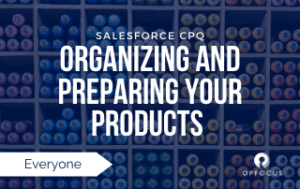Organize and Prepare Products for Salesforce CPQ
 When your team decides to bring on CPQ, there are steps you can take to ensure a seamless implementation. The first thing your team will need to do is identify your products. This ensures a smooth and clean implementation that works with how your team operates. So, let’s discuss how and why your team needs to organize and prepare products for CPQ success.
When your team decides to bring on CPQ, there are steps you can take to ensure a seamless implementation. The first thing your team will need to do is identify your products. This ensures a smooth and clean implementation that works with how your team operates. So, let’s discuss how and why your team needs to organize and prepare products for CPQ success.
What are Products?
To get started your team needs to identify the products that currently exist in your database. Simply put, PRODUCTS are what you sell, what you invoice, and how you make money. They are the building blocks to having a successful Salesforce CPQ Platform.
At the start of every CPQ project are in-depth discussions on your company’s products. The purpose of these discussions is to gain an understanding of:
- Product organization and identification
- Product Types
- Pricing methods
- Allowable Quantities
- Discounts available and discount limits
- Product selection and configurations
It’s essential to clearly identify products and understand specific business cases when having this discussion on how to create your products in Salesforce CPQ. Products and Pricing are the foundation in the Configure, Price and Quote process and drive the success of your user experience. Some of the areas this process will affect include:
- Creating Quotes
- Understanding Products Configuration
- Pricing Accuracy
- Quote Presentation
- Reporting
What type of homework should I do?
Working with CPQ consultants will drive the discussions to the depth required to fully understand all the needed setup requirements and help generate ideas to make your CPQ system fully functional. To ensure these discussions are efficient, it’s important to gather your product data into one collective sheet ahead of time. Doing the initial homework to identify products in terms of these high-level features, however, will benefit both your company and the consultant’s ability to be efficient.
Product Homework: Identify Each Individual product with:
- Product Identification
- Product Name
- Product Code
- Product Family
- Description
- Product Type
- One-Time Products
- Subscriptions Products
- 1 Month Subscription
- 1 Year Subscription
- Pricing Method
- List Price
- Percent of Total
- Other
- Can the Quantity be adjusted by the Sales Rep?
- Can the pricing be adjusted by the Sales Rep?
- Can there be a discount on this product?
- Is the product dependent on another product being sold?
While these high-level starting points to identify how products and pricing will be configured are essential to understand. Therefore, the earlier your team is able to provide this information, the smoother the implementation will be. CPQ consultants will help transform these products and pricing identifications into recommendations using CPQ best practices.
Recommendations can include:
- Bundle configuration
- Automate Product Select
- Configuration error messages
- Automate Discounts
- Etc.
Projects can sometimes be delayed from the start if teams don’t take the time to think through how their products and pricing function. Your team should identify how this currently functions and what you’d like the process to look like in the future. The discovery discussions with a CPQ consultant can easily stretch a 1-2 week deep drive to properly understand the information provided and explore best practice suggestions, into expanding a project’s time frame additional months. This is often caused by delays tracing down product information, getting the pricing methods agreed upon, and identifying quote creation goals.
Final Thoughts
Products are the foundation of a successful Salesforce CPQ project. While CPQ consultants understand best practice implementation and common practices, it’s essential to organize and prepare products for CPQ at the beginning of a CPQ project and ensure you’re following Best Practices. Get your team bought into your upcoming CPQ project by clearly conveying its ROI. Then look at what other teams have accomplished and see if it’s in line with the results your company is looking for. If your team is considering a CPQ project or recently started one, connect with one of our specialists. Our team has performed dozens of implementations and understands the importance of customizing CPQ to fit your needs.


